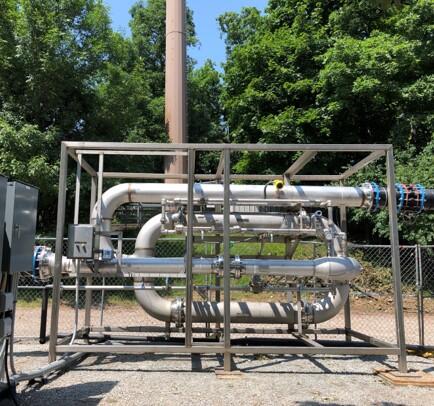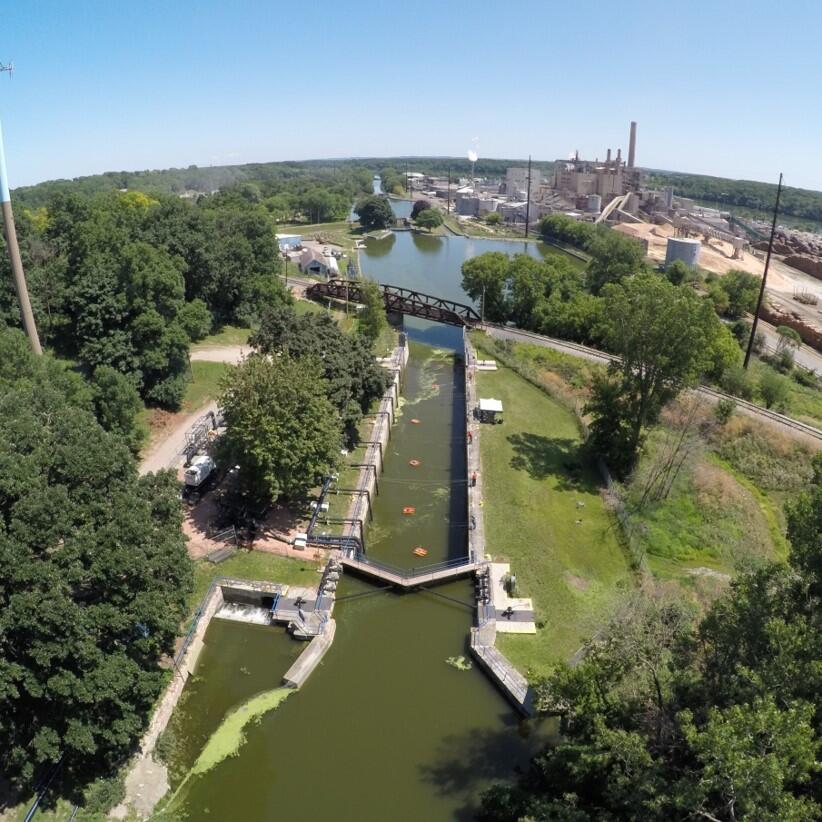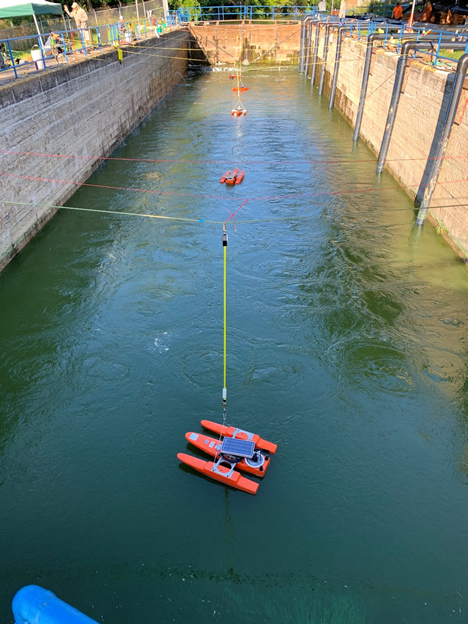Engineering and Testing of Carbon Dioxide Infusion Systems
Management agencies have identified key pinch-points where there is a need to block invasive carp passage. Recent studies have shown that carbon dioxide (CO2) can be an effective behavioral deterrent for invasive carps and could be used independently or in combination with other deterrents to reduce the risk of migration into new areas. Installation of a deterrent at these management locations requires extensive architecture and engineering to understand the feasibility of CO2 as a fish deterrent under various conditions and scales.

Invasive Carp Control: Carbon Dioxide
The goal of this project is to design and test a large-scale CO2 infusion system to determine its feasibility at relevant management scales. Prototypes have been designed to minimize potential interference with navigation, while simultaneously optimizing CO2 gas-transfer to maximize efficiency. Studies are conducted in flumes, ponds and field settings (e.g. navigational locks) to collected operational data related to the engineering and costs of a CO2 deterrent system.




Links associated with this project.
https://tomcosystems.com/
Registration of Carbon Dioxide–Carp
Effects of Carbon Dioxide on Non-Target Organisms
Carbon Dioxide for General Aquatic Invasive Species Control
Carbon Dioxide as an Invasive Carp Lethal Control
Carbon Dioxide as an Invasive Carp Behavioral Deterrent
Below are publications associated with this project.
Evaluation of a carbon dioxide fish barrier through numerical modelling Evaluation of a carbon dioxide fish barrier through numerical modelling
Application of the technology readiness levels framework to natural resource management tools Application of the technology readiness levels framework to natural resource management tools
Performance of a carbon dioxide injection system at a navigation lock to control the spread of aquatic invasive species Performance of a carbon dioxide injection system at a navigation lock to control the spread of aquatic invasive species
Investigating the mixing efficiencies of liquid-to-liquid chemical injection manifolds for aquatic invasive species management Investigating the mixing efficiencies of liquid-to-liquid chemical injection manifolds for aquatic invasive species management
Field evaluation of carbon dioxide as a fish deterrent at a water management structure along the Illinois River Field evaluation of carbon dioxide as a fish deterrent at a water management structure along the Illinois River
Below are partners associated with this project.
U.S. Geological Survey, Central Midwest Water Science Center
U.S. Geological Survey, Western Fisheries Research Center – Columbia River Research Lab
U.S. Geological Survey, Upper Midwest Water Science Center
Fox River Navigational System Authority
USACE Chicago District
USACE Engineer Research and Development Center
UW Platteville
Management agencies have identified key pinch-points where there is a need to block invasive carp passage. Recent studies have shown that carbon dioxide (CO2) can be an effective behavioral deterrent for invasive carps and could be used independently or in combination with other deterrents to reduce the risk of migration into new areas. Installation of a deterrent at these management locations requires extensive architecture and engineering to understand the feasibility of CO2 as a fish deterrent under various conditions and scales.

Invasive Carp Control: Carbon Dioxide
The goal of this project is to design and test a large-scale CO2 infusion system to determine its feasibility at relevant management scales. Prototypes have been designed to minimize potential interference with navigation, while simultaneously optimizing CO2 gas-transfer to maximize efficiency. Studies are conducted in flumes, ponds and field settings (e.g. navigational locks) to collected operational data related to the engineering and costs of a CO2 deterrent system.




Links associated with this project.
https://tomcosystems.com/
Registration of Carbon Dioxide–Carp
Effects of Carbon Dioxide on Non-Target Organisms
Carbon Dioxide for General Aquatic Invasive Species Control
Carbon Dioxide as an Invasive Carp Lethal Control
Carbon Dioxide as an Invasive Carp Behavioral Deterrent
Below are publications associated with this project.
Evaluation of a carbon dioxide fish barrier through numerical modelling Evaluation of a carbon dioxide fish barrier through numerical modelling
Application of the technology readiness levels framework to natural resource management tools Application of the technology readiness levels framework to natural resource management tools
Performance of a carbon dioxide injection system at a navigation lock to control the spread of aquatic invasive species Performance of a carbon dioxide injection system at a navigation lock to control the spread of aquatic invasive species
Investigating the mixing efficiencies of liquid-to-liquid chemical injection manifolds for aquatic invasive species management Investigating the mixing efficiencies of liquid-to-liquid chemical injection manifolds for aquatic invasive species management
Field evaluation of carbon dioxide as a fish deterrent at a water management structure along the Illinois River Field evaluation of carbon dioxide as a fish deterrent at a water management structure along the Illinois River
Below are partners associated with this project.
U.S. Geological Survey, Central Midwest Water Science Center
U.S. Geological Survey, Western Fisheries Research Center – Columbia River Research Lab
U.S. Geological Survey, Upper Midwest Water Science Center
Fox River Navigational System Authority
USACE Chicago District
USACE Engineer Research and Development Center
UW Platteville






